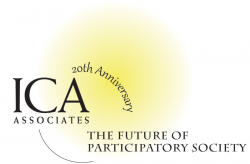Professional Association Collaborates to Grow
The Request by the Organization
The national board of a health profession made up of twelve people from several different provinces wanted to hold a two and a half day retreat to come up with a plan that would be cohesive across the country and that would allow a potential membership of many thousands of people to “row in the same direction.†They wanted to revisit the organization’s mission because the external global problems and pressures on the members of the profession were never anticipated by the old mission. They were aware that the structure of the organization was not up to the task and that structural adjustments would be needed, even though they did have an administration company that handled membership dues and some communication. They were all aware of their small financial reserves. None of these people had any particular solutions in mind, but just knew that urgent decisions and actions were needed.
The Situation and Factors at Play
The profession needed to create an important plan for the next four years. The organization had a membership of 1,600 from a potential of 36,000 members, but it was an unincorporated association, under the umbrella of another organization. A series of problems on a global scale and of a life-threatening nature, was taking its toll on the general population and the media was quick to publicize anything that was linked to those problems. The profession had members who were on the front line dealing with some of the issues and therefore was under constant scrutiny by the media. Media seized on unflattering facts and shortfalls of any body that was related to the issues. The profession was being constantly negatively portrayed in media in spite of being on the front line trying to work in the midst of the chaos.
In this actual case, the profession was under siege by events in society, professional credibility was shaken, and some among the membership were depressed. The board of directors had all been members for many years, and wanted to get the profession back in good stead in society. They wanted the membership to grow and the association to give quality service to all its members. The problems that were created by the global issue became a rallying point for the board and they decided to seize the moment and make sure that the profession moved ahead in spite of the difficulties and by the media. They decided to strategize deeply and signal that common action was needed by all members, not just a few leaders.
The Planning
The two and a half day ToP Participatory Strategic Planning session was preceded by five telephone interviews with separate board members. The event process included an historical scan, mission discussions, vision, contradictions and strategy workshops, organizational structure discussion, two year action planning and team assignments. After the event a first draft of documentation of the planning was sent to the board members within two weeks.
Impact and Results
The organization was registered as a corporation. A new board and committee structure was created that spread the workload and responsibility across the country and the membership. The administration of the organization was shifted from the third party management firm to a full time Administrator. Before the strategic plan, the annual budget was about $10,000. Five years later the organization handled about $500,000 in various project grants and initiatives. The new structure has enabled the organization to handle about twenty major projects over the years.





